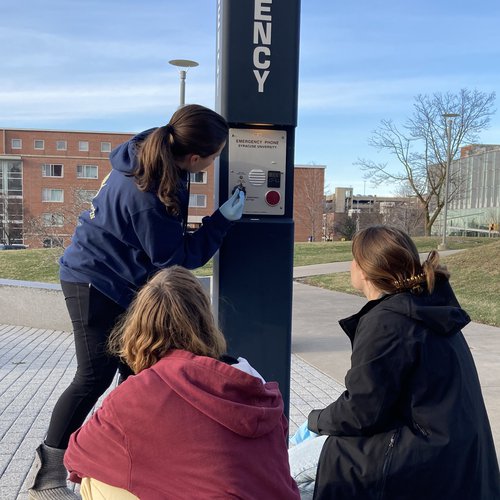Bringing CSI into the Classroom
Students in the College of Arts and Sciences’ Advanced Crime Scene Investigation class gain valuable hands-on skills to prepare them for a career in forensics.
Dusting for fingerprints, documenting blood stain patterns and measuring bullet trajectory – you might think this is a description of a recent episode from the popular television series CSI. While this may be true, these are also the daily lessons students are learning through hands-on research in the Advanced Crime Scene Investigation class offered by the College of Arts and Sciences’ Forensic and National Security Sciences Institute (FNSSI).
Taught by Adrian Grenier, a retired New York State trooper with over 25 years of experience in the field, the class introduces students to complex aspects of various forensic disciplines. Throughout the semester they learn valuable tricks of the trade used by actual investigators at real crime scenes. From using Super Glue fumes to lift fingerprints off evidence to employing special lasers and smoke to determine bullet trajectory, students walk away from the course with skills that they can immediately apply to the workplace.
The class culminates with students processing a full mock crime scene, where they even don Tyvek suits to make the experience truly authentic.
“There’s significant documentation that goes into the scene,” says Alyssa Grzesiowski ’22, a course assistant who helped instruct the class. “They are taking photographs, they are taking notes, and they are drawing sketches of horizontal and vertical surfaces that they will use to produce their final report.”
Students work in teams to process evidence laid out by Grenier and Grzesiowski in a classroom inside the Life Sciences Complex. The scene includes ballistic evidence, blood stain patterns, fingerprints and more.
“The goal for the students is to document the scene as accurately as possible and, in their presentation, give any analysis of their findings,” says Grzesiowski.

In addition to processing a crime scene, students become familiar with various methods of fingerprinting. Similar to the way no two fingerprints are the same, substrates, or surfaces on which fingerprints are taken from, can vary greatly. Whether testing for prints on a window, a piece of paper, or a plastic bottle, each requires a unique approach for successful identification. Students learn different methods of fingerprint analysis including the brush and powder technique, how to test for prints with chemical spray, and even how to use Super Glue fumes to reveal prints under a black light.
Grenier says the hands-on nature of the course and applicable skills students acquire make it extremely popular across disciplines.
“This (class) would improve your marketability,” Grenier says. “It just makes you a more well-rounded candidate. Let’s face it, with the CSI shows and that whole genre of shows, getting into the field is competitive and you need to make yourself stand out a little bit.”
Find more information on the Forensic Institute.
